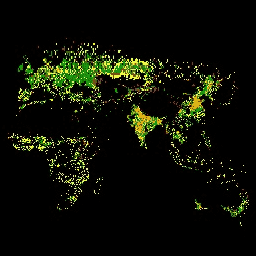
- 데이터 세트 사용 가능 기간
- 2010-01-01T00:00:00Z–2010-01-01T00:00:00Z
- 데이터 세트 제공업체
- Global Food Security-support Analysis Data at 30m Project (GFSAD30)
- 태그
설명
GFSAD는 21세기 글로벌 식량 안보에 기여하는 고해상도 글로벌 농경지 데이터와 물 사용량을 제공하기 위해 NASA의 지원을 받는 프로젝트입니다. GFSAD 제품은 다중 센서 원격 감지 데이터 (예: Landsat, MODIS, AVHRR), 보조 데이터, 필드 플롯 데이터를 사용하여 농경지 역학을 문서화하는 것을 목표로 합니다.
명목상 1km 규모에서 V0.1은 Thenkabail 외(2009a, 2011), Pittman 외(2010), Yu 외(2013), Friedl 외(2010)의 4가지 주요 연구에서 파생된 세분화된 5개 클래스 글로벌 농지 범위 지도의 공간 분포를 제공합니다. V1.0은 전 세계 경작지 면적과 관개 농업 대 천수답 농업에 관한 정보를 제공하는 5개 클래스 제품입니다. 작물 유형 또는 작물 유형 우세 정보가 없습니다. 시계열 원격 감지 데이터를 사용하여 모든 픽셀에 대해 자르기 강도 (단일, 이중, 삼중, 연속 자르기)를 얻을 수 있습니다. GFSAD1000 명목상 2010년 제품은 2007~2012년 데이터를 사용하여 생성되었습니다.
대역
픽셀 크기
1,000미터
대역
| 이름 | 최소 | 최대 | 픽셀 크기 | 설명 |
|---|---|---|---|---|
landcover |
0 | 9 | 미터 | 마스크 클래스 설명 자르기 |
토지 피복 클래스 표
| 값 | 색상 | 설명 |
|---|---|---|
| 0 | 검은색 | 농경지 외 |
| 1 | orange | 경지: 관개 주요 |
| 2 | 갈색 | 경작지: 관개 경미 |
| 3 | darkseagreen | 경지: 강수 |
| 4 | green | 농지: 강수, 소규모 조각 |
| 5 | 노란색 | 농지: 강수량, 매우 작은 조각 |
이용약관
이용약관
대부분의 미국 지질조사국 (USGS) 정보는 퍼블릭 도메인에 있으며 제한 없이 사용할 수 있습니다. 정보 소스로 USGS를 인용 또는 표시에 관한 추가 정보를 확인할 수 있습니다.
인용
Earth Engine으로 탐색하기
코드 편집기(JavaScript)
var dataset = ee.Image('USGS/GFSAD1000_V1'); var cropMask = dataset.select('landcover'); var cropMaskVis = { min: 0.0, max: 5.0, palette: ['black', 'orange', 'brown', '02a50f', 'green', 'yellow'], }; Map.setCenter(-17.22, 13.72, 2); Map.addLayer(cropMask, cropMaskVis, 'Crop Mask');
